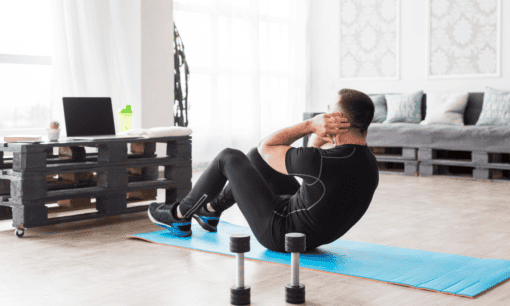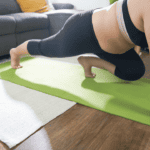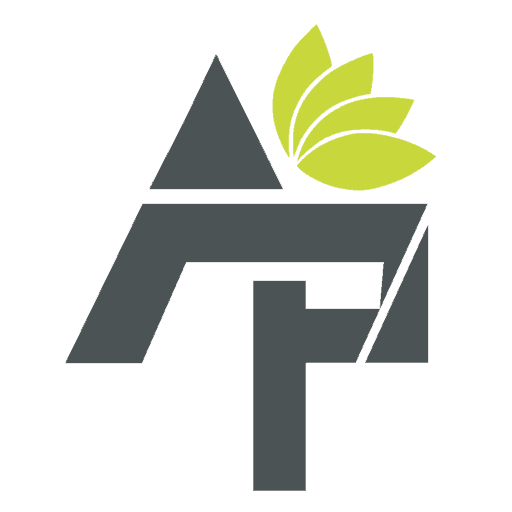When I started searching for a continuing education unit to support my work as a trainer, I looked at a few different options, one of which was the ISSA Strength and Conditioning Specialization.
I was surprised once I started to find that a lot of the chapters contain information I didn’t expect. It was a particularly large course, one I didn’t realize was as long as it was, but that worked out for the best because the chapters with a lot of robust information specific to program design really compensated for the chapters that I didn’t need as much because I had covered them in several other courses.
Topic Contents
The ISSA Strength and Conditioning Specialization

The ISSA’s Strength and Conditioning Certification course is a unique program that teaches the principles of body mechanics, anatomy, and metabolism as they relate to exercise and training for athletic performance.
With a substantial textbook, this course covers things like athletic anatomy and how the body can adjust energy and performance levels with the right type of exercise instruction. It provides you, as the potential coach, with the tools you need to communicate exercise instruction successfully, using things like hundreds of videos shown from different angles so that you can teach safe and effective form. Not only that, it helps you identify areas where athletes might be overtraining, prevent injuries, and apply principles of good supplements and nutrition to individual athletic needs.
Cost
- Around $800
What is Included in the Cost
- You get the textbook with the most up-to-date information
- you get an online reference guide so that you can work through your course unit by unit and focus on the most important personal trainer concepts
- ISSA includes a practice exam and quizzes so that you can prepare for your final exam
- There is an online exercise lab that shows over 250 animated exercises from three different angles with 3D animations so you always know how to teach proper form and technique
- A final exam that can be done online or through a pen and paper exam
- A student forum where you can talk to master trainers with any questions you might have
- Options to design a free website as a personal trainer, with five different editable designs and fully hosted content
- Unlimited educational support through the online portal
CE Credits
- 20 credits–If you have any other certification and you need continuing education units to keep your certification current, this course will fulfill your needs with ISSA and many other companies
What I Love
- The robustness of this curriculum feels like a steal for the price
What I Don’t Love
- The course length
Course Layout
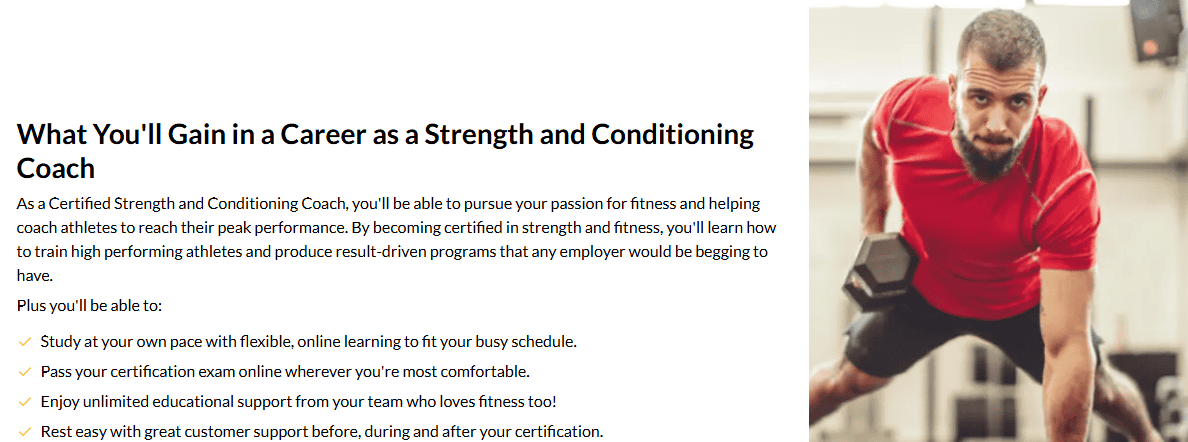
I’ve done a lot of courses through ISSA, and this one was a bit of a challenge for me.
I don’t mind the somewhat boring and repetitive layout that is 20 pages of chapter reading, a 3-minute video, 20 more pages of chapter reading, and a 5-minute video, if the course is only around 10 weeks.
But the textbook for this course is almost 600 pages.
It’s one of the biggest textbooks I’ve seen out of all the courses I’ve taken so you are reading a much bulkier amount every week. And one of my issues with that is the textbook is digital. You can pay extra and have a physical book shipped to you, but the digital copy can be straining on the eyes. I would much rather sit and read a physical textbook if I’m going to have to read a hundred pages then scroll through a clunky interface online.
In theory, that digitized version makes it more accessible, no matter where you are, and makes it easier because they have the search function within the text, so you could search for a specific topic during your open-book quiz or open-book test. However, that search function doesn’t apply to the whole text because of bad coding. A lot of the sections that are tackled in quizzes and the final exam are usually the side notes or the headers, basically, content that is structurally different from the main body. The search function doesn’t apply to that content, so you might as well just pay extra for the physical textbook and save your eyes the strain.
Video Content
Aside from that, ISSA does a great job with a lot of the student resources, in particular the video content.
When you take this course, you’ll have access to an exercise video library. That library contains 250 different animated exercises, and it uses a 3D animation model showing that particular exercise from three different angles.
This makes it possible for you to look up specific exercises, especially things like plyometric exercises or lower and upper body exercises mentioned in several of the chapters in this book. With those videos, you can actually see how those exercises are performed so that when you teach them to your clients, you can ensure safe and proper technique.
Course Length
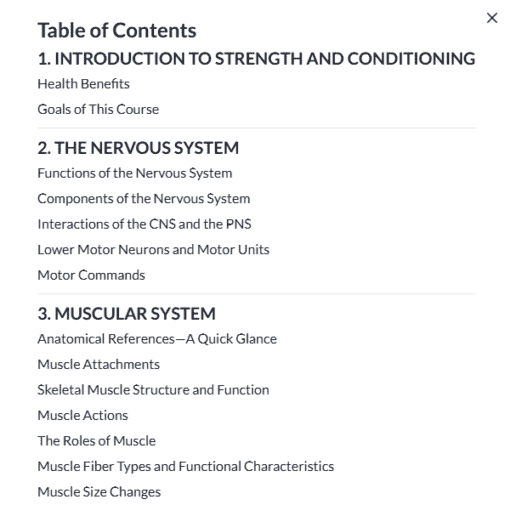
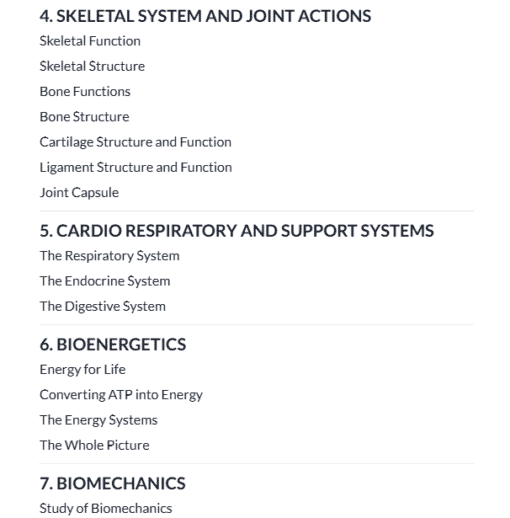
This course gives you up to 8 months to finish.
You’re going to need it.
This is one of the most robust courses I have ever taken with ISSA. There are a few that might have a slightly bigger textbook, so they have a few extra weeks worth of chapter reading, but this one, as I said, has significantly more hours of content to it.
There are 23 chapters divided into 12 modules, so in theory it will take you about 12 weeks to finish or 3 months, but that is based on studying between 1 and 2 hours per day. I can tell you based on personal experience that there will absolutely be weeks where you don’t finish a full module because of how much reading there is.
One module might have three chapters, each of which have around 40 pages of reading, video content, and quizzes.
So you can see how this time really adds up because you are looking at, let’s say, 2 hours of reading and videos in addition to your live weekly content and other video resources. And that’s just for one chapter, where you might have three chapters in one week.
Unlike some of the other courses that are only 10 weeks long with around 1 to 2 hours of coursework each week, this one is very substantial, so come prepared.
Textbook
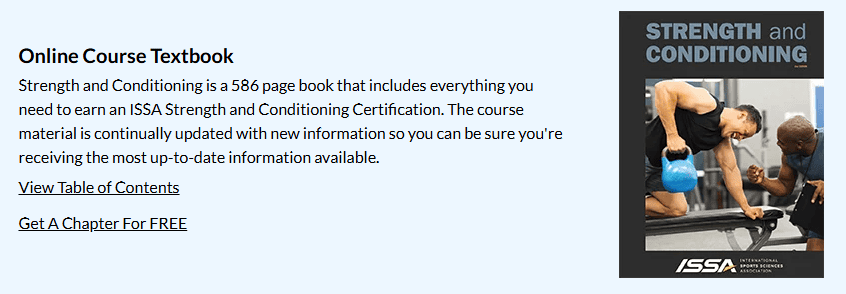
The textbook, as I mentioned, is almost 600 pages. It covers a ridiculous amount of topics, including:
- The nervous system and how it functions
- The muscular system, including anatomical references the roles of different muscles, and muscle size changes
- The skeletal system and how the joints function
- The cardiovascular system, endocrine system, and digestive system
- Bioenergetics and how your body converts ATP into energy
- Biomechanics
- How to assess health and fitness, or cardio-respiratory health, for your clients
- How to conduct performance assessments for things like reactive strength, speed, and agility, or maximal strength
- How to design training programs for your clients
Some of the chapters were pretty fascinating, especially taking a deeper look at joint function and musculoskeletal systems, but in the first half of the textbook, you start to veer into content that might have already been covered in other courses, like the nutrition coach or personal trainer courses, specifically things like how your body converts ATP.
That isn’t necessarily a bad thing. After all, repetition is probably the best way to really retain information, but it almost feels like that content was just copied and rewritten from another textbook at times. In the grand scheme of things, that’s not the worst, especially if they want to maintain the same integrity across the content for each textbook, but it speaks to some corner-cutting for a few chapters.
I really started to like the content in the middle of the book, the meat of the textbook, so to speak.
Here you found in-depth content specific to the field of strength and conditioning, like:
- Flexibility and stretching
- Plyometric exercises
- Core exercises
- Lower body exercises
- Upper body exercises
- Power and Olympic-style weightlifting
- Resistance training systems with training parameters and microcycles
- Applying periodization in the preparation or preseason and competition or in-season programs
- Cardiorespiratory programming for the preparation and competition phase, as well as cyclic athletes
- Recovery and injury prevention, and how to care for injuries in athletes
From there, the book pivots to nutrition and supplementation. This was a pretty big section, focusing on the importance of hydration, different supplements to increase endurance versus absolute strength. I was able to learn something from these chapters, but I was also disappointed that they had pretty strong overlap in some of the other courses, like a certified nutrition coach.
When you get to the end of the book, that’s when you start to see the more technical content, focused on performance psychology, running a professional practice, and what your role is as a strength and conditioning coach.
I get it, there is overlap in the content, so obviously it has to be included, but it almost felt like I paid for the same content two or three times in two or three certifications.
Summing Up
Overall, this course provided a lot of tools on how to create personalized fitness programs specific to increased strength and conditioning for clients. I was very impressed with the chapters on Fitness assessments and how to monitor progression and growth for an athlete.
If you want to pivot your practice so that you aren’t just providing personal training sessions for people in recovery or people just starting, but more specifically for athletes, this is a great specialization to have. It tackles the fundamentals of sports psychology and how you can not only assess and support athletic progress but help your athletic clients overcome their personal setbacks and achieve new goals.
Alt Protein Team is a team of professionals and enthusiasts committed to bringing you the most up-to-date information on alternative protein, health and wellness, workouts, and all things health-related. We’ve reviewed a lot of products and services so you don’t have to guess when you spend your hard-earned money on them. Whether you want to shed some pounds, build lean muscle or bulk, we can help you figure out what you need to do and what you need to have to achieve your goals.

